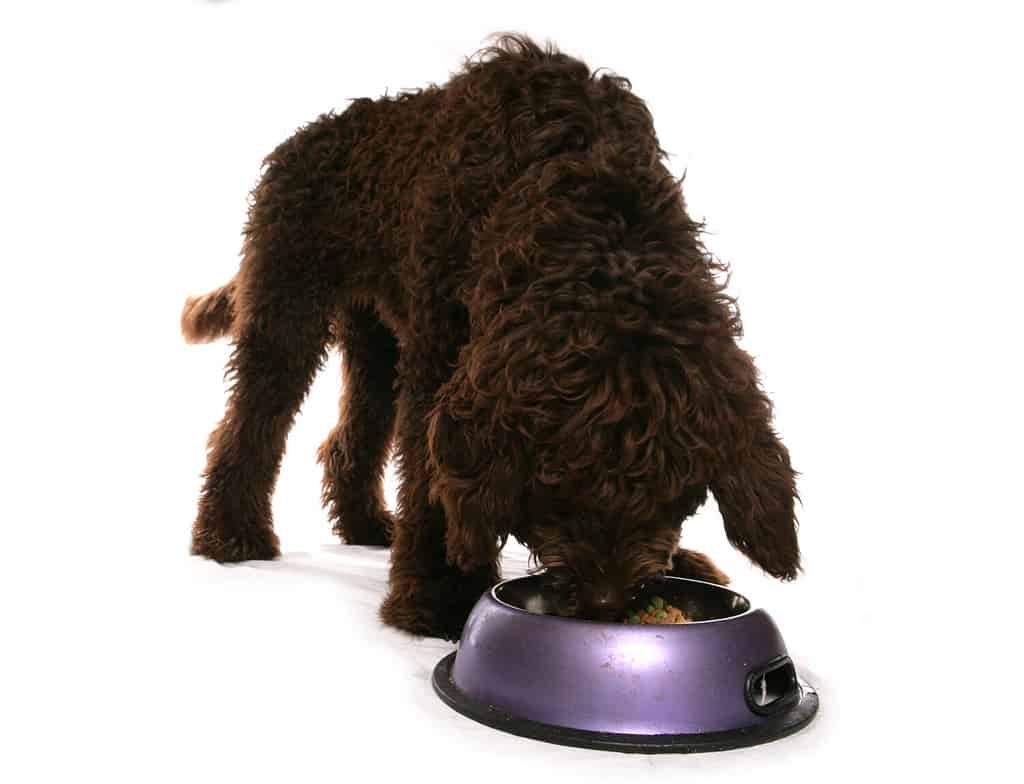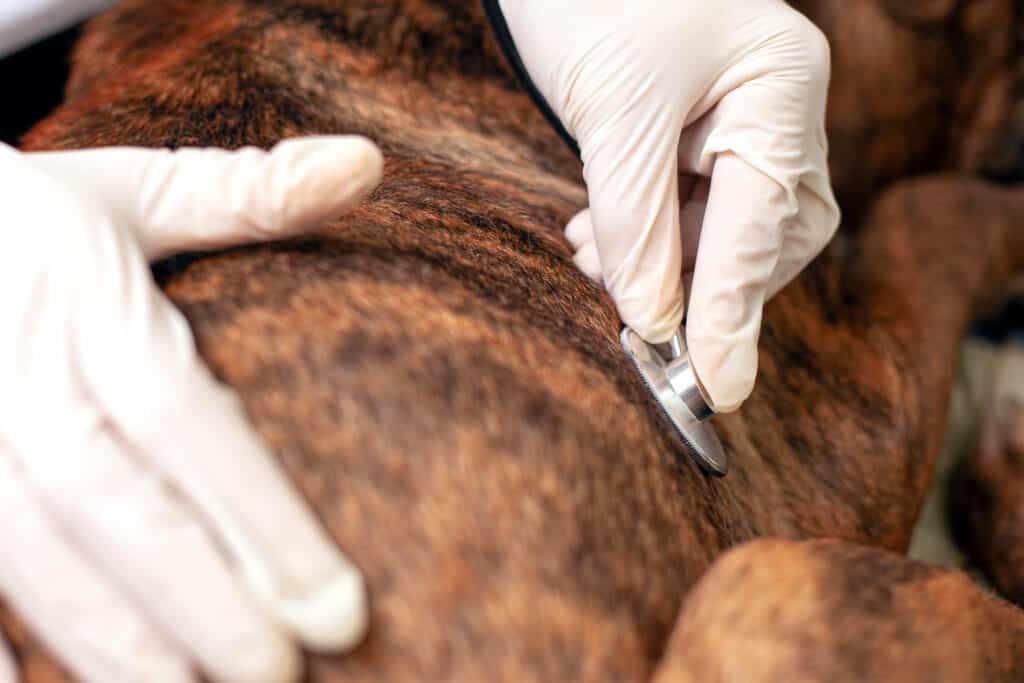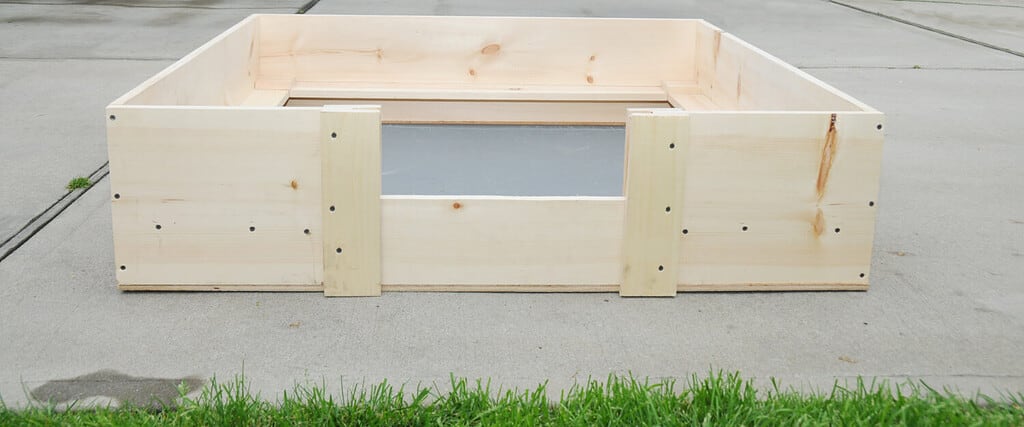As you can probably guess from the name, a labradoodle is a mixed breed of a poodle and Labrador retriever. The rapid rise in popularity of the labradoodle is not shocking. It’s hard to deny the cuteness of these pooches!
A labradoodle will give their family their undivided attention and is happiest when they are with the ones they adore. They are a joy because they have the enthusiasm of the Labrador retriever and the diligence of the lab and the poodle.
This dog breed might soon become one of the most well-liked mixed breeds available. They can be calm and serene while snuggled around your feet, however, they can also spring up and start playing fetch at any time.
Today we’re going to look at everything you need to know if your labradoodle becomes pregnant. Let’s start with what to look for regarding signs and symptoms.
Labradoodle Pregnancy Symptoms

©Angeline Dobber/Shutterstock.com
You may become aware of the numerous emotional and physical symptoms if your dog is pregnant. To start, about a month after mating, a mild mucus discharge could happen. Approximately 30 days after mating, her teats could change in size and color, and you might notice that they secrete a semi-clear fluid.
Your dog may throw up a bit in the first trimester of pregnancy, similar to how we experience morning sickness. Talk to your veterinarian if this persists or if you have any questions or concerns. Beginning about day 35 of her pregnancy, she will begin to gain weight, which might be up to 50% above usual.
Though first-time mothers carrying a tiny litter might not show as much, you ought to be able to see her distended belly approximately 40 days into the pregnancy. She might behave a little more calmly than normal or lose some of her appetite. If any of these symptoms worry you, talk to your veterinarian.
Throughout the second phase of pregnancy, your pregnant dog’s hunger may grow, so be ready to adjust her diet appropriately.
Gestation Period: How Long Are Labradoodles Pregnant?
When labradoodles hit puberty, typically when they are approximately nine months old, dogs begin their heat cycle for the first time. However, in certain instances, heat may begin when they are 12 to 15 months old.
Two times a year, at the beginning of spring and again in autumn, dogs usually go into heat. The time to build up to heat may take between 14 and 21 days. While labradoodles often give birth on day 63 of their 58–68-day gestation period, this is not always the case.
Keep tabs on your dog’s pregnancy timetable and be alert for any labor-related symptoms including a sudden decrease in body temperature, excessive pacing, and nesting.
Pregnancy Care for Labradoodles
Once you’ve established that your furry friend is pregnant, there are a few things you should do to keep her comfortable, happy, and healthy until she gives birth.
Update Her Diet

©chrisbrignell/Shutterstock.com
Making sure your expecting pup is properly nourished is among the most crucial things you are able to do for her. You won’t need to alter your dog’s diet for the initial two-thirds of her pregnancy if she is already eating high-quality dog food and is at a normal weight unless the vet instructs you differently. In fact, adding more food at this point may be hazardous.
As her weight increases in the final weeks of her pregnancy, vets suggest progressively increasing the volume of food she consumes until she consumes 35 to 50% above her norm. Because eating a lot can be uncomfortable, gradually boost her intake while giving her modest, regular meals.
Regular Vet Visits
Bring your dog in for a prenatal exam at the vet prior to breeding her if that’s the route you’re going. She needs to get all of her shots. Your dog’s vet is going to suggest either getting your dog dewormed with a medicine that is best for her before mating. The vet may also suggest a fecal examination in order to look for intestinal parasites.
It is now believed that deworming the expectant dam with a suitable dewormer beginning in her third trimester and continuing for at least two weeks after whelping greatly decreases the prevalence of roundworm and hookworm in infant puppies, enabling them to develop and flourish to their fullest potential.
Planning the Birth
Along with making a plan with the entire family and your dog’s sitter, you should additionally inquire with the vet about what to do if there is any kind of an emergency close to the time when labor is anticipated. Visits to the vet on a regular basis can keep your dog healthy throughout pregnancy.
The vet will check your dog for any possible physical or anatomical issues that can hinder them from delivering a usual whelped litter once you’ve confirmed that the pooch is pregnant. This is a wonderful time to talk about prenatal planning, including if a cesarean delivery should be thought about and booked in advance.
Keep Her Active

Labradoodles are relatively calm at the vet.
©Ysbrand Cosijn/Shutterstock.com
A number of veterinarians think that restricting vigorous exercise throughout the first couple of weeks of pregnancy would improve the implantation of the embryos if you’re attempting to breed your dog. Normal exercise is then acceptable until your pet’s belly enlarges.
The optimum activity for your dog throughout her third trimester should not be too demanding. The mother-to-be will benefit more from shorter and perhaps more frequent outings because she requires the stamina to carry the puppies and provide them with food.
Average Litter Size for Labradoodles
Five to 10 puppies can be born to a litter of labradoodles. You are able to bring the dog to the vet during week five of pregnancy to have an ultrasound done so you can find out exactly how many puppies the dog is going to give birth to.
The total number of puppies in the litter is influenced by the size, maturity, and level of fertility of the canine.

This dog breed comes in just about every natural color!
©Lindsay Helms/Shutterstock.com
What to Expect in Week 1
Ovulation and fertilization occur during the initial week after mating. The fertilized eggs will descend from the uterus during this stage and implant themselves into the uterine wall.
It’s a great idea for dog parents to create a pregnancy schedule and estimate their pet’s due date by understanding when she is ovulating. Keep in mind that ovulation is necessary for efficient reproduction, although it may be difficult to determine if your dog has made eggs or not. To verify ovulation, someone should keep track of your dog’s heat cycle.
The majority of dogs do not exhibit pregnancy symptoms at this point in time, although pregnancy does cause hormonal shifts in your dog’s body. Even though you won’t see any outward changes, some dogs may become ill in the morning. Yet, the majority of dogs don’t act or look differently and this is a rather uncommon occurrence.
At this point, you should keep playing with your dog and feeding her the best dog food as you did before she got pregnant. Additionally, unless your vet advises differently, there is no reason to add any dietary supplements at this time.
What to Expect in Week 2
The developing embryos gradually start to grow in the second week of a canine’s pregnancy. The embryos are still quite little at this stage and don’t require a lot of energy to develop normally. Because of this, it’s not necessary to change your dog’s diet and you can keep feeding her exactly how you have before.
From week two moving forward, you will need to routinely check your dog’s weight and record measurements of her belly. Until she’s reached the end of the fifth week of pregnancy, your dog’s weight should stay consistent or go up by a maximum of 10%. The pups could possibly be at risk if your furry friend beings to lose any weight. If this happens, call your vet to get your dog checked.
You are able to keep exercising and spending time with your dog as usual because the pregnancy remains in its infancy. Feel free to take her on walks, throw frisbees, and the like. You are also not yet obligated to change how frequently you wash and groom your dog.
What to Expect in Week 3
Now, the embryos shall form within the uterine lining throughout the third week of the canine pregnancy. The pups will get all the important nutrients they need for healthy development and growth inside this secure layer. Because the puppies are only a couple of centimeters in size, you won’t see any obvious changes to your dog’s overall appearance.
You shouldn’t alter any components of your dog’s normal routine and keep her normal exercise and eating schedule. However, some dogs may begin to have a greater appetite at this time, so keep an eye out for it and slowly introduce more food.
What to Expect in Week 4
Things really start developing during the fourth week! An expert breeder or veterinarian will be capable of confirming the pregnancy at this point by softly touching your dog’s abdomen. Please leave this to the professionals; otherwise, you risk harming the unborn puppies.
The vet will also be capable to carry out an ultrasound to ensure that you can get a rough idea of how many puppies your dog will deliver. The soon-to-be pups will grow to be almost an inch long by the end of the fourth week.
Along with their faces, eyes, and spines, many features will start to take shape. Because the fourth week of pregnancy is one of the most critical developmental weeks of pregnancy, the puppies are more likely to have defects during this time.
At this stage in your dog’s pregnancy, it’s best to minimize roughhousing and physically demanding play that could threaten the puppies. While you shouldn’t completely stop walking your dog, it’s best to take some precautions if necessary.
If this sounds like something you need to do, choose a relaxing walk rather than taking your dog for a run, and street clear of strenuous exercises.
What to Expect in Week 5

Going to the vet is essential all throughout the pregnancy.
©fukume/Shutterstock.com
By the conclusion of the fifth week, embryogenesis, the initial stage of gestation, concludes and the second one begins. Now called fetuses, puppies during this part of the development start to grow internal organs and quickly start to gain weight.
The puppies aren’t as likely to have any developmental issues from this point on, which is fantastic news. Puppies start to develop separate toes, claws, and whiskers just after the one-month mark. The vet is capable of determining the sexes of the puppies during the fifth week as well.
Because the puppies will begin to acquire weight faster at this point in the pregnancy, your dog will also start to gain a lot of weight. Because of this, you have to begin providing your dog with additional food and modifying her diet.
Start giving your dog multiple smaller meals throughout the day. A vet will be able to guide you on the amount of food the soon-to-be mother needs during this part of her pregnancy. The very may even suggest which type of dog food your pooch will benefit from most.
What to Expect in Week 6
During the sixth week of pregnancy, your dog’s pups’ anatomical development starts to quicken. The puppies will start to get their unique traits at this point and their skeletal system will begin to get solid.
Around this time, your dog’s pregnancy will be noticeable to everybody and her stomach will show that she’s pregnant. If you haven’t changed her diet at this time, you should do that now. To avoid nutritional and caloric deficiencies, begin giving your dog high-end dog food specifically created for consumption during pregnancy.
It’s not uncommon for dogs to become less hungry due to the difficulty that pregnancy can bring. For the benefit of the developing puppies, your dog is going to require a lot of nutrients from the food.
What to Expect in Week 7

A labradoodle puppy will grow its distinct fur around week seven of a pregnancy.
©Sharon Snider/Shutterstock.com
The puppies’ hair will start to grow at the seventh-week mark. During this time, their skeletons will continue to solidify. Ironically, the mother dog can start losing hair on her tummy. This is a natural occurrence that helps her get ready for delivery.
In the seventh week of your dog’s pregnancy, you should begin making preparations for the arrival of your newborn puppies. It’s perfect to set up a whelping box for your dog now! Pick a quiet area away from any household activities where your dog will feel at peace and at ease giving birth to her newborn offspring.
What to Expect in Week 8
Your veterinarian can perform an x-ray at this point to check the precise quantity of the litter. The decision as to whether or not this type of procedure is required rests with you and your veterinarian because it may be too intrusive.
Following that, your dog might give birth at any time, so make sure you have everything prepared. Make sure you have everything you need, and now is the time to make any necessary modifications to the whelping area.
Your dog will start lactation around the two-month mark, which is a sure sign that she’ll give birth shortly. You can anticipate when a dog will give birth because most start lactating around seven days before giving birth.
What to Expect in Week 9
As she waits to give birth, your dog will begin to nest in her whelping container and may become anxious and agitated. Be present to comfort and assist your dog once she goes into labor while attempting to remain calm and exhibit no symptoms of panic.
Keep in mind that the majority of dogs are smart and able to handle any scenario on their own. To alleviate your worries, you can let your vet know that your dog has begun whelping and place them on call in the event your dog requires assistance.
How to Prepare for Labor and Delivery

Whelping boxes can be purchased or created at home!
©rSnapshotPhotos/Shutterstock.com
As the end of her pregnancy approaches, your dog’s breasts and nipples may visibly expand, and you might see some creamy fluid once the milk glands mature and swell. As she moves, her stomach will get bigger and possibly wobble a bit.
The puppies may even start to move about inside their mother in the latter part of the pregnancy. By now, you should be getting yourself and your pooch ready for whelping or giving birth to puppies.
Setting up a whelping area is the ideal method for doing this. Whelping areas provide your dog with a warm, dry, draft-free, and easy-to-clean place to birth her litter. Whelping areas are available for purchase in the form of a pox, or you could even use a little plastic kiddie pool.
The mother needs to be able to enter and exit the whelping box with ease, but not the puppies. Even though you can easily access it, your pregnant pup might prefer placing it in a peaceful part of the house.
How to Care For Your Labradoodle Afterward
Check that the mother immediately cleans the puppies. When the puppies arrive in the world, the mother dog should immediately begin grooming them. Give her a few minutes to remove the puppy’s sac and begin licking and washing it.

Labradoodles rarely shed and are hypoallergenic.
©Unknown/Shutterstock.com
If it takes your dog more time than that, you can jump in, remove the sack, and gently stroke the puppy to encourage breathing and help it dry. Check to see if the pups are breastfeeding. Within one to three hours of birth, puppies should begin nursing.
For the puppy to understand, you might need to carefully squeeze some milk out of a nipple while holding it directly in front of the newborn. Warm up the delivery area. Puppies have to be kept warm since they have trouble controlling their body temperatures. Keep one part of the whelping box at 85 degrees Fahrenheit for the initial few days following delivery.
Finally, bring the mother and puppies for checkups at the vet. Once the puppies are born, plan a checkup appointment with your veterinarian. The veterinarian will check on the mother’s recovery and the growth of the puppies.
The photo featured at the top of this post is © Jne Valokuvaus/Shutterstock.com
Ready to discover the top 10 cutest dog breeds in the entire world?
How about the fastest dogs, the largest dogs and those that are -- quite frankly -- just the kindest dogs on the planet? Each day, AZ Animals sends out lists just like this to our thousands of email subscribers. And the best part? It's FREE. Join today by entering your email below.
Thank you for reading! Have some feedback for us? Contact the AZ Animals editorial team.






